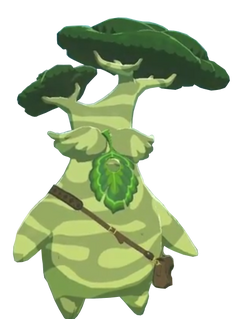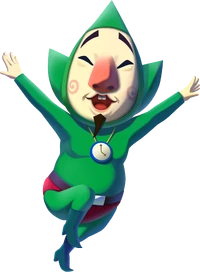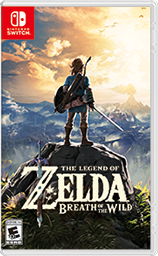by David Steffen

If you’ve played either of the two recent Nintendo Switch-based Legend of Zelda games (Breath of the Wild and Tears of the Kingdom) long enough, you know Hestu, the most distinct of the Koroks. After playing these games and other games in the Legend of Zelda series for many, many hours, I have “discovered” (developed a headcanon) that explains the secret origins of Hestu and why Hestu is different from all the other Koroks.
Who Is Hestu?
If you’re not familiar: The Koroks are forest spirits whose home is in the Korok Forest which is protected from the outside world by The Lost Woods which earns its name by being filled with a confounding fog that will take you back at the entrance if you wander from a pre-set path. Although that’s their home, they can be found all over Hyrule, approximately a thousand of them to find in little hiding spaces (plus some more that aren’t hiding). Koroks as a whole look like little roughly crafted humanoid child-like figures with a big leaf for their face. Each Korok looks a little different, from the color and shape of the leaf to the exact proportions of their body but generally they look like this. They can be found hiding under rocks, or will appear from nowhere if you win little shooting games or spatial puzzles or other little challenges. They are generally childish and fun-loving and love to play hide-and-seek. Tears of the Kingdom added a recurring new kind of Korok: the traveling Korok who is going to visit a friend but has packed such a large backpack that it has grown too tired too move. Finding or helping this multitude of Koroks will give you the reward of Korok seeds. Which is a little weird if you think about it–are those like Korok babies? Apparently the game-makers intended them to be Korok poops.
The use for poop-scooping for the Korok kids is unclear until you meet Hestu. After helping with a side quest in Breath of the Wild to recover Hestu’s magical maracas, he asks if you can help him find all the Korok seeds that the mischievous little Koroks have stolen from him, and whenever you do Hestu will perform a magical dance that will expand your weapon, bow, or shield inventory slots.
Okay, so what is Hestu’s backstory? After playing Breath of the Wild, and after playing Tears of the Kingdom for dozens of hours, I had not really given it any thought at all. Why does he need a backstory? He’s the forest spirit dude who expands your inventory and while he is likeable and funny and useful, does he really need a backstory? Until the connection spontaneously popped into my head.
Hestu’s Origin
I randomly realized where Hestu came from: Tingle finally fulfilled his greatest wish to become a fairy. Hestu is Tingle transformed!

I will go into more detail below, but even superficially they have quite a few similarities. They are both adults with facial hair (OK Hestu’s beard is a leaf, but it appears to be in the place of facial hair), taking on the appearance in some way of an adult version of the Great Deku Tree’s children. They both have a love of words they made up (“Kooloo-Limpah” vs “Shak-Shakala”, though the latter is probably onomatopoeia for the sound of maracas, it is not a common onomatopoeia as far as I am aware). They both have a preference for glitter.
Wait, Who?
OK, so if you’ve only played the Zelda games on Nintendo Switch you might not know who Tingle is.
Tingle first appeared in Majora’s Mask which was released in the year 2000. Tingle claimed to be the reincarnation of a fairy, something which has been a central part of his character in all of his appearances. He is 35 years old and his father who works at the swamp tourist center is exasperated by his son’s insistence that he is a fairy. Tingle wears a green jumpsuit with a pointy hood, presumably meant to resemble Link’s classical outfit of a green tunic with a pointy hat. He can often be found in that game floating above a scene attached to a big red balloon. If you pop the balloon he will fall to the ground and will sell you maps of different areas.
He’s appeared in several other games, most notably in The Wind Waker where he has a more prominent role, but keeps the same backstory, claiming to be a fairy.
Supporting Evidence
Bear with me, there are quite a few pieces of information I took into account for this theory.
Tingle does not directly appear in the Switch games, but he is referenced. There is a “Tingel Island” on the east coast of Hyrule. In the Breath of the Wild expansion pack, and in the regular Tears of the Kingdom game, there is a Tingle clothing set. The clothing set could be an alt universe thing, like a branched timeline–it seems like at least some of the Link-themed clothing sets come from alternate universes, so Tingle’s might be the same. But Tingel Island seems like more of a solid clue that it’s not only an alt universe reference. So I think that could be interpreted as meaning that Tingle has existed by that name in the universe.
When Tingle says he is a fairy, what does that mean? Generally when the Zelda series refers to a “fairy” it is most often referring to a tiny flying glowing creature with transparent butterfly wings. These tend to be able to heal damage to Link instantaneously, or when collected and stored in Link’s inventory may be able to revive Link from what would otherwise be fatal damage. There are also fairies with the same appearance (such as Navi, and Tatl) that help Link by helping him target or by giving him advice.
There are also the Great Fairies which tend to take the appearance of giant women who reside in pools of water and grant Link boons (enhanced clothing or better weapons or shields) in exchange for something (money or monster parts or other things).
But I don’t think Tingle is referring to either of these kinds of fairy. His wardrobe is the biggest clue. Majora’s Mask is a direct sequel to The Ocarina of Time. In The Ocarina of Time, Link has grown up in the Deku Forest. He thinks that he is a Kokiri, one of the forest children who all have fairy companions except for Link. But it turns out that Link is not a Kokiri–his lack of fairy is a clue, but the other Kokiri can also not leave the Deku Forest, and the other Kokiri do not age as Link does in Ocarina of Time. For the actual Kokiri, the fairy seems to be an intrinsic part of their existence–there is no Kokiri without a fairy. From a distance, you can’t see the childlike Kokiri, only the flying fairy companion and the Kokiri fades in as you approach. My interpretation of this is that the fairy is the more real or solid one of the pair, and the childlike form is just a projection from this particular variety of fairy. So, in my interpretation, a Kokiri not only has a fairy companion, it is a fairy and Tingle’s wardrobe is meant to show that.
The next step to understand here is that Kokiri are equivalent to Korok (I had not recalled that this detail was supported by game canon in The Wind Waker, at least according to this wiki page). They both have their primary home in a forest connected to the Lost Woods, with their guardian the Great Deku Tree. They are both childlike in both appearance and behavior (apart from Hestu who has a more adultlike proportion and size, but again Hestu appears to be anomalous). To be fair, their appearance differs, and the Koroks are not limited by the boundaries of the forest. If they are equivalent, what accounts for the differences? Apparently the great flood that caused the world to be a series of islands in The Wind Waker caused the transformation. But it’s not uncommon in the series of the games for familiar things to take very different forms from one game to another. In the original Legend of Zelda game the Zora were just another monster, popping their head out of water to shoot fireballs at Link, but through the different games we have seen that they are sentient being, so we have seen how vastly different a species or race can be from game to game. The shift between Kokiri and Korok is less far-fetched than the shift of the Zoras.
Other Theories About the Anomaly of Hestu
I have wondered since I started playing Breath of the Wild years ago, why there are approximately one-thousand childlike Koroks and then there is one adultlike Korok. What life cycle accounts for this? I wondered if the Koroks are an invasive species and the Deku Tree eats them when they get to be a certain age to avoid them crowding out all other life in Hyrule. I wondered if they are always childlike and Hestu is some kind of random genetic variation. I wondered if the Koroks have a social hierarchy like bees, where changes can be triggered by environmental factors like diet, and the Great Deku Tree is the queen, and Hestu is the queen in training meant to take over the hive when the Deku Tree dies (we know the Deku Tree can die, as it did die in Ocarina of Time).
How It Happened
My thought is: Although Tingle has declared that he is a fairy, I think some part of him realizes that he is not a fairy in any objective sense. So, knowing what he wants, he sets out to find a way to become a fairy. He can either see the Koroks, or read about them in some storybook or heard about them in some myth so he finds out where they came from and goes on a quest to find their home. He eventually finds a way through the Lost Woods and approaches the Deku Tree as a supplicant, begging the Deku Tree to make him into a Korok. The Deku Tree considers for a time, and finally agrees, with a condition. The Deku Tree will turn Tingle into a Korok, if Tingle takes responsibility for all the other Koroks. It’s hard to be a parent to something like one thousand mischievous children who won’t grow up, when you’re ancient and very tired, and also when you’re literally a tree so you can’t even chase them around. A responsible adult Korok, on the other hand, would have much more energy and mobility to caretake the Koroks. Because Tingle is an adult when he was transformed, he took the form of an adult Korok even though that was unprecedented.
Conclusion
Hestu may not canonically be Tingle. But, I don’t think it’s unbelievable that the writers could’ve made it a possibility on purpose. Let me know what you think of the headcanon, if you have your own headcanon. Why do you think Hestu appears to be the only adultlike Korok?
#TingleTransformed #SecretOriginsOfHestu

